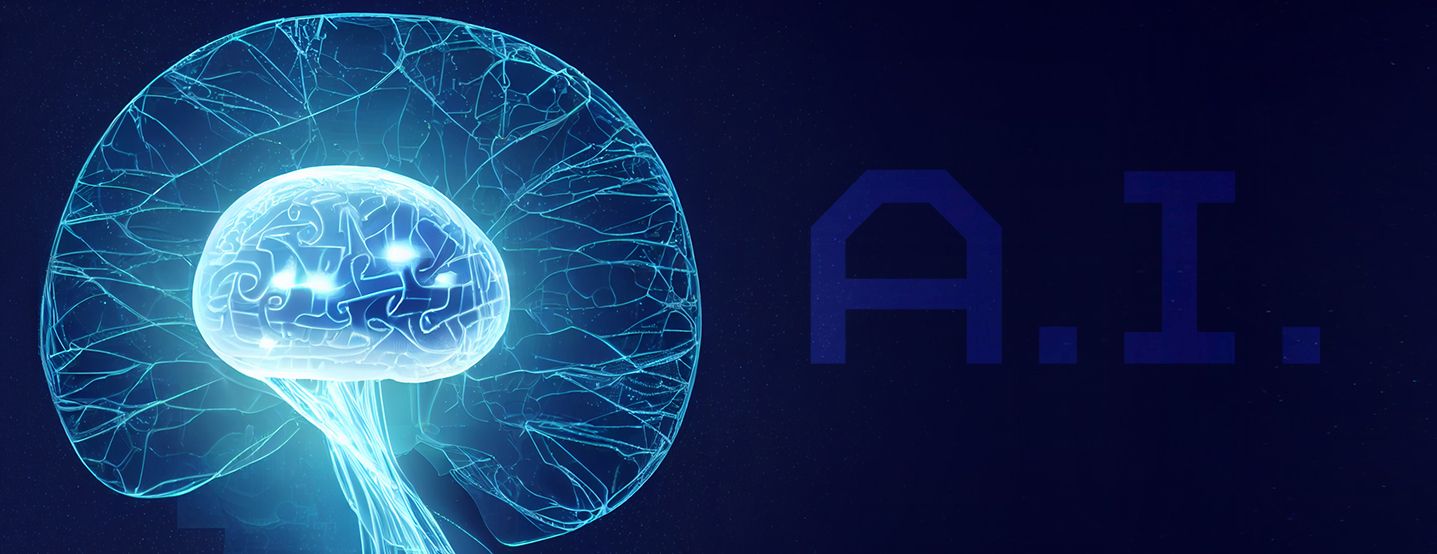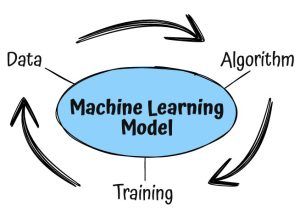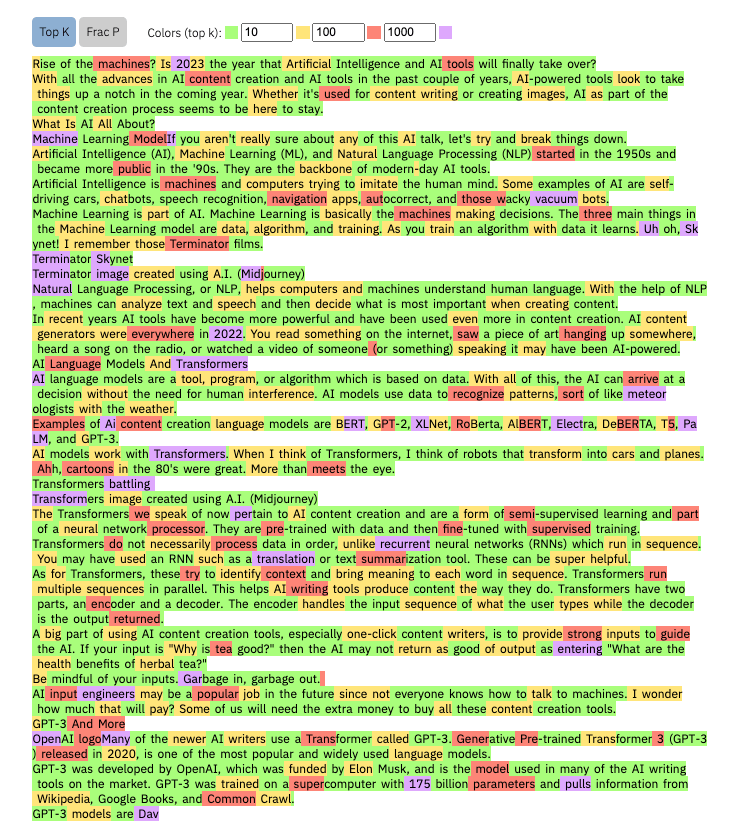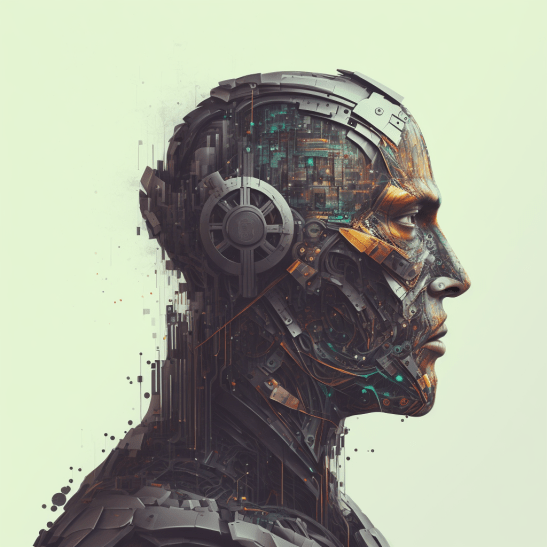AI Content Creation In 2023

Rise of the machines? Is 2023 the year that Artificial Intelligence and AI tools will finally take over?
With all the advances in AI content creation and AI tools in the past couple of years, AI-powered tools look to take things up a notch in the coming year. Whether it’s used for content writing or creating images, AI as part of the content creation process seems to be here to stay.
What Is AI All About?
 If you aren’t really sure about any of this AI talk, let’s try and break things down.
If you aren’t really sure about any of this AI talk, let’s try and break things down.
Artificial Intelligence (AI), Machine Learning (ML), and Natural Language Processing (NLP) started in the 1950s and became more public in the ’90s. They are the backbone of modern-day AI tools.
Artificial Intelligence is machines and computers trying to imitate the human mind. Some examples of AI are self-driving cars, chatbots, speech recognition, navigation apps, autocorrect, and those wacky vacuum bots.
Machine Learning is part of AI. Machine Learning is basically the machines making decisions. The three main things in the Machine Learning model are data, algorithm, and training. As you train an algorithm with data it learns. Uh oh, Skynet! I remember those Terminator films.

Natural Language Processing, or NLP, helps computers and machines understand human language. With the help of NLP, machines can analyze text and speech and then decide what is most important when creating content.
In recent years AI tools have become more powerful and have been used even more in content creation. AI content generators were everywhere in 2022. You read something on the internet, saw a piece of art hanging up somewhere, heard a song on the radio, or watched a video of someone (or something) speaking… it may have been AI-powered.
AI Language Models And Transformers
AI language models are a tool, program, or algorithm which is based on data. With all of this, the AI can arrive at a decision without the need for human interference. AI models use data to recognize patterns, sort of like meteorologists with the weather.
Examples of AI content creation language models are BERT, GPT-2, XLNet, RoBerta, AlBERT, Electra, DeBERTA, T5, PaLM, GPT-3, and GPT-4.
AI models work with Transformers. When I think of Transformers, I think of robots that transform into cars and planes. Ahh, cartoons in the 80’s were great. More than meets the eye.

The Transformers we speak of now pertain to AI content creation and are a form of semi-supervised learning and part of a neural network processor. They are pre-trained with data and then fine-tuned with supervised training.
Transformers do not necessarily process data in order, unlike recurrent neural networks (RNNs) which run in sequence. You may have used an RNN such as a translation or text summarization tool. These can be super helpful.
As for Transformers, these try to identify context and bring meaning to each word in sequence. Transformers run multiple sequences in parallel. This helps AI writing tools produce content the way they do. Transformers have two parts, an encoder and a decoder. The encoder handles the input sequence of what the user types while the decoder is the output returned.
A big part of using AI content creation tools, especially one-click content writers, is to provide strong inputs to guide the AI. If your input is “Why is tea good?” then the AI may not return as good of output as entering “What are the health benefits of herbal tea?”
Be mindful of your inputs. Garbage in, garbage out.
AI input engineers may be a popular job in the future since not everyone knows how to talk to machines. I wonder how much that will pay? Some of us will need the extra money to buy all these content creation tools.
GPT-3, GPT-4 And More
 Many of the newer AI writers use Transformers called GPT-3 and GPT-4. Generative Pre-trained Transformer 3 (GPT-3) released in 2020, and Generative Pre-trained Transformer 4 (GPT-4) released March 14th, 2023, are the most popular and widely used language models.
Many of the newer AI writers use Transformers called GPT-3 and GPT-4. Generative Pre-trained Transformer 3 (GPT-3) released in 2020, and Generative Pre-trained Transformer 4 (GPT-4) released March 14th, 2023, are the most popular and widely used language models.
GPT-3 and GPT-4 were developed by OpenAI, initially funded by Elon Musk, and are the models used in many of the AI writing tools on the market. GPT-3 was trained on a supercomputer with 175 billion parameters and pulls information from Wikipedia, Google Books, and Common Crawl. OpenAI has been a bit vaguer when it comes to the training details of GPT-4, but it sure is more powerful.
GPT-3 models are Davinci, Curie, Babbage, and Ada. The Davinci model produces the highest quality AI content and costs more than the others. The most recent Davinci model is text-davinci-003.
Ada produces the least expensive and fastest content but at lower quality.
With the cost of AI models going down, more and more AI content creation tools have shown up in the past year. There are even open-source models. GPT-J is an open-source version of GPT-3.
OpenAI recently released ChatGPT (GPT-3.5 and GPT-4). ChatGPT is already the fastest-growing platform, even beating the likes of Facebook and Netflix. The arrival of ChatGPT and GPT-4 has put AI tool founders on their toes with what will happen next, AI content possibly being watermarked, and how it may be incorporated into their own platforms.
You can speak with the ChatGPT like it’s a person that has read a lot of books, asking it to explain things in detail. ChatGPT is sort of like a robot librarian. Remember having to go to the library to learn and then write all those notes? Good times.
Some are even asking if ChatGPT could be a Google killer since it could evolve into a more advanced search engine. Still, there’s much work to be done if OpenAI pushes ChatGPT in that direction.
AI Content Vs Google
The constant battle between AI content and Google continues. Google has been increasingly going after AI-generated content. There are tools that can even detect AI-generated content such as Giant Language model Test Room, and Originality.ai, among others. Keep in mind AI detectors are not foolproof, and that often human-written content may be flagged as AI created by these detectors.
Was this article written using AI? No Google, I promise it was written by me. Though I may or may not be using AI grammar and SEO tools during the process. Maybe if I used AI to write this content it would be better?
Take a look at the screenshot below of the AI detection test from this very article. You will see other colors breaking up the green. This is a signal of it being human-written content and not AI. If it was more green and fewer other colors, then it’s most likely AI-created.

So if we know, then Google knows. After all, Google is one big AI platform itself.
Google wants to reward content that provides value and helps users. Google documentation says “Avoid creating search engine-first content”. Just be careful when using AI tools in your content marketing strategy, especially if you are not editing or fact-checking the content. If Google does one day drop the hammer on AI-generated content it can mean a big drop in search engine rankings for many.
But just when we think Google may have caught up to AI tools not their own, AI authors like OpenAI release another impressive update.
This battle seems similar to the case in professional sports where some athletes cheat by using performance-enhancing drugs. The chemists always seem to be one step ahead of the drug testers. Will the AI content creation tools stay one step ahead of Google and its own AI?
Examples Of AI Content Creation Tools
There is a bunch of different type of AI content generator tools on the market. Some of these tools are used for content creation while others are for content optimization.
AI SEO optimization tools like SurferSEO, Cora, and PoP are great optimizers that help in writing for SEO. These platforms will assist in getting your website article to rank higher on search engines.
The AI Natural Language Generation (NLG) tool Quillbot is an AI rewriter that will spin existing content to make it more unique. Many news outlets and marketing agencies have been using tools like Quillbot to create content.
Don’t want to sound like a dope? Well, there’s an AI tool for that. Grammarly is a great AI writing assistant tool that will help make sure your content has proper spelling and grammar.
Frase is an AI SEO tool plus an AI content creation tool in one. Frase can help users do research for an article, have the built-in AI write it, and then optimize it so it ranks higher on Google.
 Popular AI writers include Jasper (previously Jarvis), ZimmWriter, TextBuilder, Copy.ai, Rytr, GoCharlie, and Article Forge. These writing tools run on fine-tuned GPT-3. Some of these writers can also create ad copy, social media content, and create images among other things. The Magic Command feature in TextBuilder and Jasper is actually similar to what ChatGPT does.
Popular AI writers include Jasper (previously Jarvis), ZimmWriter, TextBuilder, Copy.ai, Rytr, GoCharlie, and Article Forge. These writing tools run on fine-tuned GPT-3. Some of these writers can also create ad copy, social media content, and create images among other things. The Magic Command feature in TextBuilder and Jasper is actually similar to what ChatGPT does.
Users may also go directly to the source and purchase tokens from the AI authors such as OpenAI, Stability.ai, AI21labs, and co:here. AI platforms like Riku and AI Content Labs are AI playgrounds that act as a sort of AI wrapper. Users would connect their AI source account to either of these tools.
With ChatGPT arriving on the scene there have been some ChatGPT Chrome extensions like AIPRM that help in creating content. If you would like a similar experience to ChatGPT but use your OpenAI account, such tools like TypingMind are great as well.
If you ever wanted to paint a picture but can’t even draw a stick figure, try Midjourney. Midjourney is an AI image creator that works on a mix of Stable Diffusion and their own fine-tuned ai that’s putting artists out of business.
Another AI image learning model is DALL-E, or now DALL-E 2, which was also developed by OpenAI and used on multiple AI content creation tools.
There are also many other types of AI tools such as transcription tools, keyword research tools, customer service platforms, plus AI video and audio tools. Machines have been really busy learning all this stuff.
Will AI Writing Tools Replace Human Writers?
Some now even worry that Artificial Intelligence tools may replace part of the human workforce. AI-powered writing tools are getting better and better, but are they still as good as human writers? GPT-4 is definitely taking some work from the writing workforce.
Ai writers are impressive at writing articles, complete stories in fiction, poetry, business plans, computer programming codes, and more with just a click of a button.
Need content ideas? AI writers will give users a great foundation and even generate content ideas for writing. AI-produced content should always be edited and fact-checked, especially if you would like the article to get visibility on Google Search.

While AI writers can produce a lot of quality content quickly, and cost much less than a human writer, it often misses that human element of humor and personality. AI-written content can write about historical events but will go off the rails and make up some facts here and there. Be sure to fact-check that AI!
OpenAI and others are also working on watermarking their AI so it will differentiate to readers between what is human-written content and AI-written content. This could slow down the rush of AI content on the internet and keep human writers in business.
Human-created content is still superior to AI-generated content, but for how long? If AI-powered writers get a personality, watch out humans.
Yes, Artificial Intelligence tools are pretty amazing and only getting better. When one AI expert was asked about the future of AI platforms his response was “everyone should have the power to build their own AI tools, that is the future. Almost like no code builders/ whitelabel, and then monetize their creation to their own audience”.
An AI content creation tool can absolutely help in creating high-quality content, I just wouldn’t rely solely on them in your content strategy and writing process. Try and use them to get things rolling and as guides to speed up your workflow.
Have fun out there and keep creating content, whether the machines help you or not.